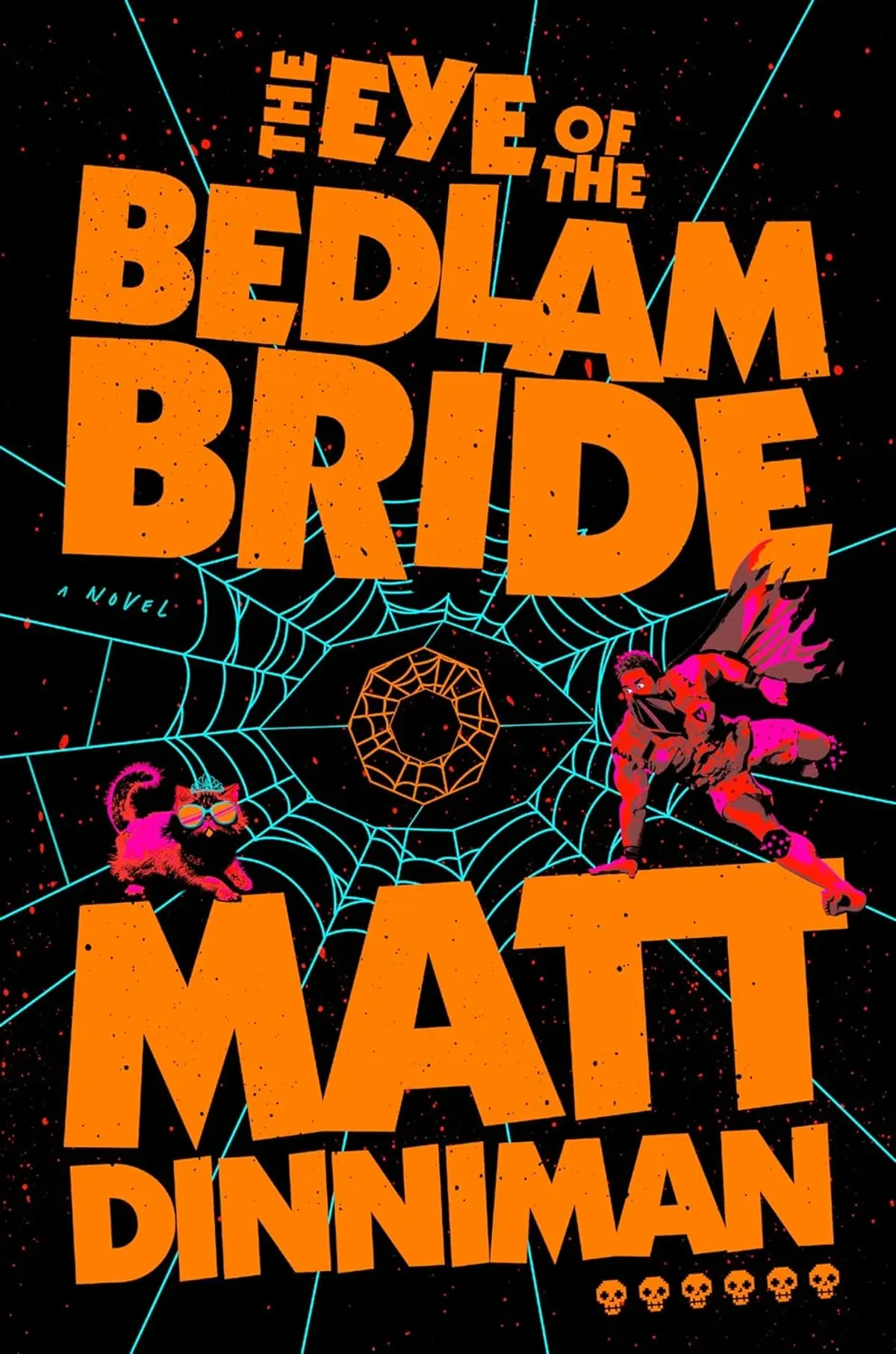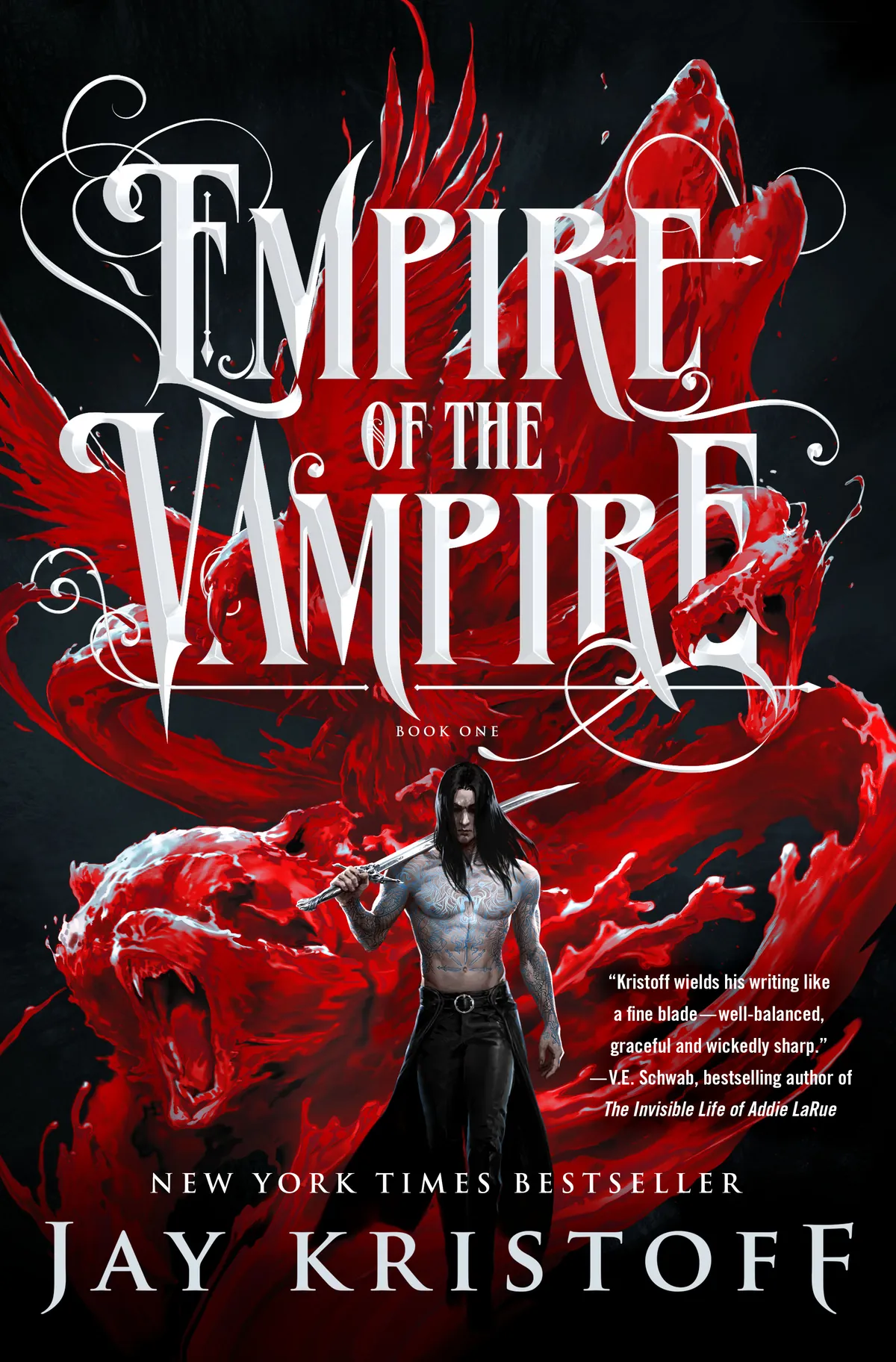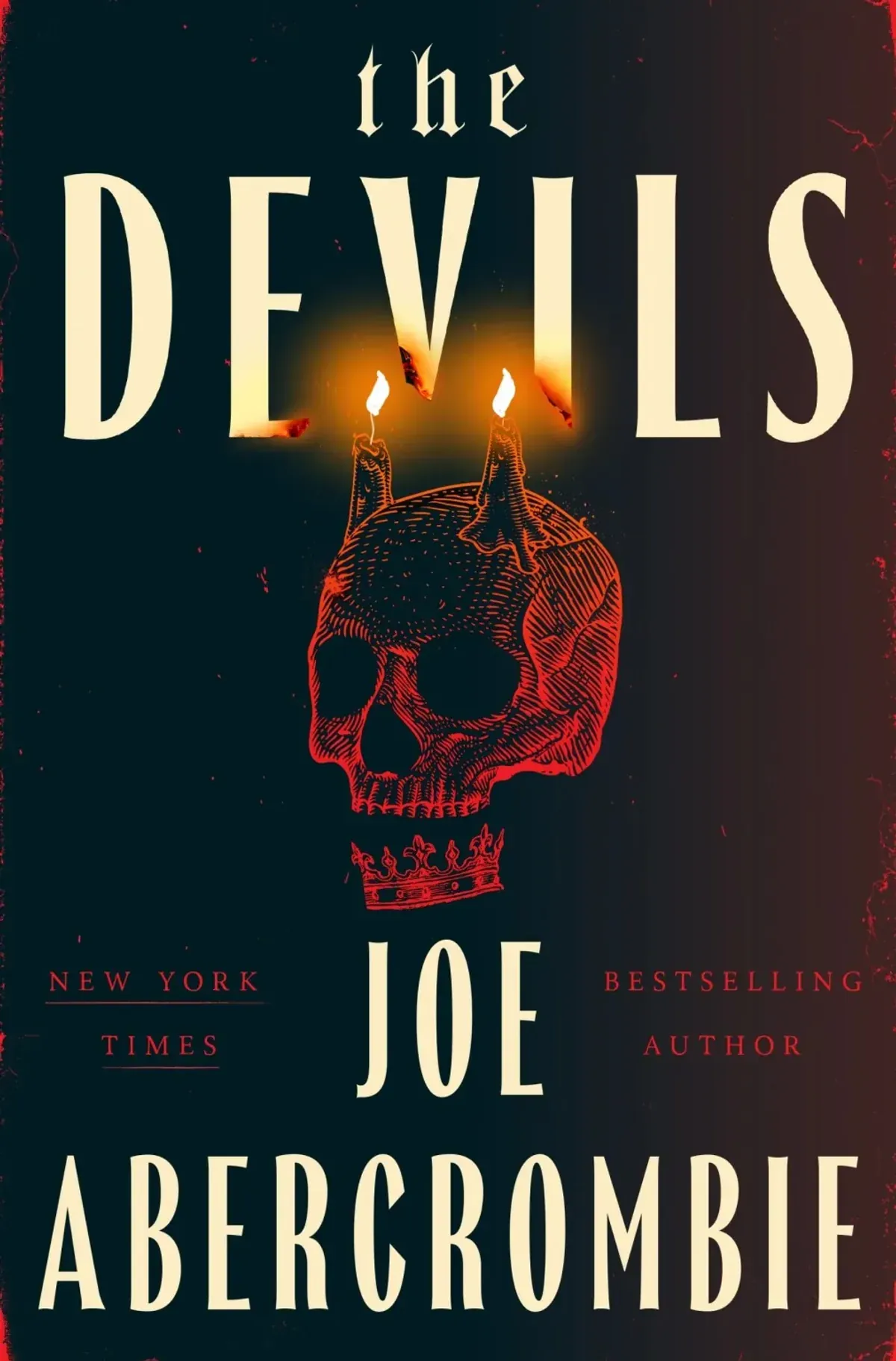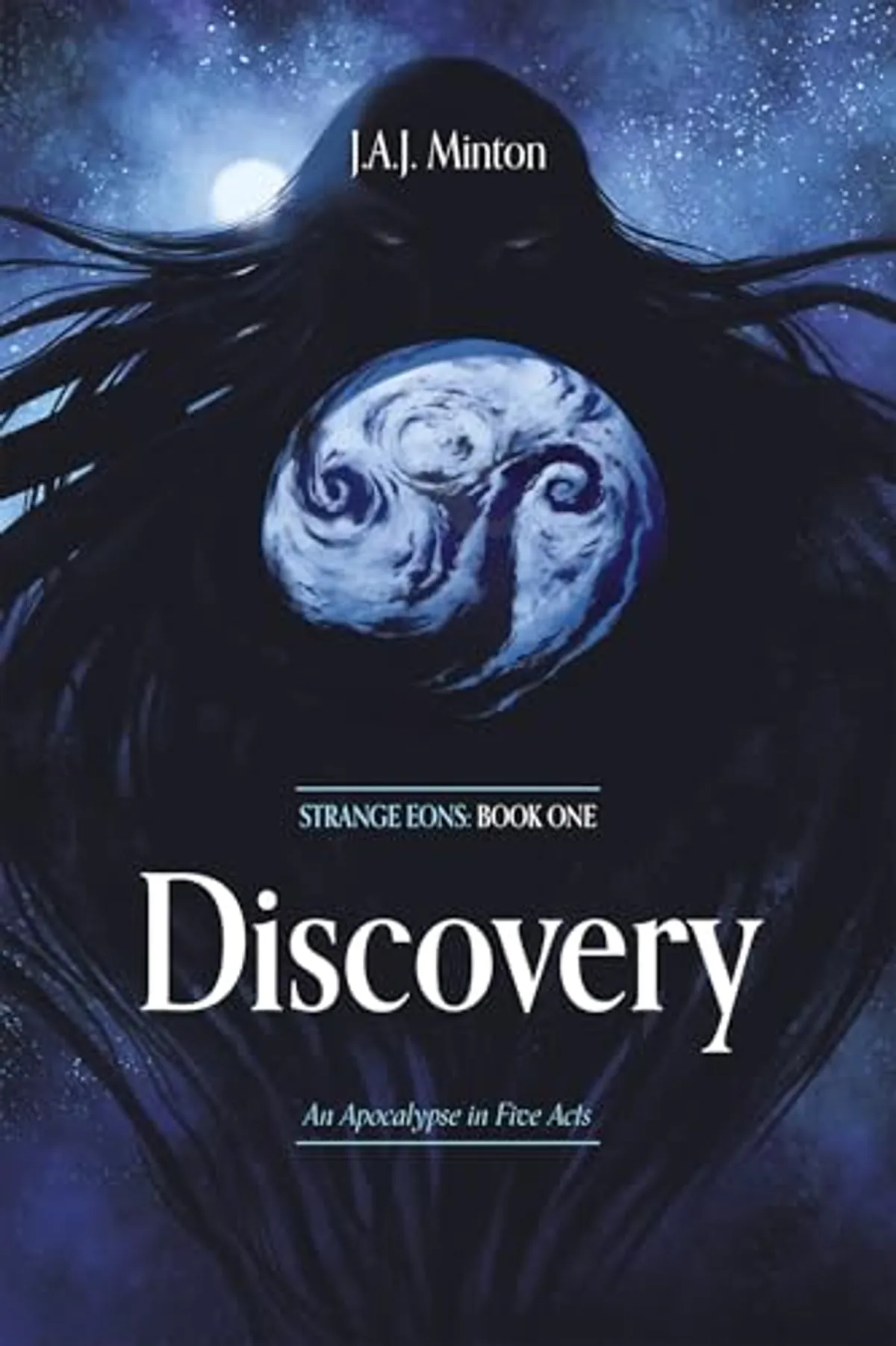The Eye of the Bedlam Bride
by Matt Dinniman
Reviewed by Devin Ford on July 3, 2025
Est. Reading Time: 12 min

Quick Info
Title: The Eye of the Bedlam Bride
Author: Matt Dinniman
Series: Dungeon Crawler Carl (Book 6)
Published: May 13, 2025
ISBN-13: 9780593956045
At a Glance: Card Battles, Ghosts, and Cuban Legends
Descending onto the eighth floor, Carl and Princess Donut find themselves dropped into a literal ghost town. The simulation of Earth’s last moments before the Calamity features reenacted human memories as specters alongside monsters from regional folklore that physically menace the streets. In pre-Calamity Havana the duo must track down six legendary beasts to convert into monster cards which function similarly to Pokemon cards while making sure they avoid becoming prey themselves since they can pass through ghosts but not live monsters or people.
The T’Ghee totem system allows players to capture monsters which can be reused as summons but requires a major risk investment to capture top-tier monsters while the dungeon AI system shows escalating signs of degradation. As if things weren’t tense enough.
While tracking regional folklore beasts Carl and Donut must face Carl’s most painful memories as Katia deals with her substance abuse.
Building on Excellence: Character Depth Meets Innovation
The Eye of the Bedlam Bride picks up the series’ emotional intensity, while also breathing new life into its mechanics. It never once feels gimmicky, but rather is integrated into the game in a way that makes it feel organic. It’s easily one of Dinniman’s strongest entries in the series, balancing both the humor we’ve come to expect from the series, with real trauma and struggle, without feeling either exploitative or heavy handed. It’s thoughtful, evocative, and funny.
As mentioned above, the eighth floor’s environment means that all physical objects can be interacted with, while human “ghosts” cannot. This leads to some interesting strategic decisions, where Carl can swipe weapons from ghost soldiers, or even force ghost cars to drive around and change up the physics puzzles. The collection of cards throughout the floor brings in another element of strategy and complexity to the puzzles, but doesn’t bog down the character work that makes this series so remarkable.
Dinniman also smartly incorporates some Cuban folklore into the floor’s story, avoiding generalizations and stereotypes, as it’s clear that he put some research into regional mythology, and handles Caribbean folklore with respect while still adapting it to his offbeat, gruesome dungeon world. The mechanic of playing a card game is also a great story beat that carries throughout the floor, while setting up the larger events for the ninth floor.
Characters: Found Family Under Pressure
Carl’s back story comes into focus in a way that it never has before. I think his pragmatic survivalist approach and his protective streaks make sense to the readers because it’s revealed just how much he had to suffer as a child. Dinniman does a very good job here. He ensures the reader isn’t subjected to cheap emotional manipulation and maintains respect for the character’s trauma rather than exploiting it for dramatic effect. At the same time he makes it clear how these traumas influence the choices Carl makes in the here and now.
Princess Donut continues to make the transition from pampered party show cat into a true leader, but this level also challenges her to new limits as she’s now not only trying to understand the card playing but also to help keep the group emotionally balanced. The character’s growth and the dynamics of her relationship with Carl both feel earned after five books of shared survival.
Katia’s battle with her drug addiction is probably the emotional core of the book and it is delivered in a way that really hits the mark. Dinniman never shies away from the ugly and the messy parts, neither here nor in how Carl’s reactions to Katia’s struggles are tied into how he’s come to terms with his own childhood trauma. Katia’s journey is hard and it’s painful and a relief. It’s just so very true to the process that it’s really, to me, the best aspect of the book. It shows just how far Dinniman has come as a writer in a way that’s hard to ignore.
The various members of the gang they’ve gradually managed to create over the course of their adventure get to go through the wringer as well and all of them deal with real issues. The bonds they form between each other are real and believable because they are the product of shared trauma and their support for each other rather than sheer convenience.
Plot: Strategic Collection Meets Emotional Resolution
The card collection framework establishes objectives alongside character advancement and environmental exploration. The objectives are more satisfying than on some of the previous floors where I felt they were arbitrary. The T’Ghee totem risk/reward choices are meaningful and additive to the narrative.
The middle segments experience pacing issues because the monster hunting becomes repetitive. These slower segments become engaging because of character dialogues and discoveries within the ghost-memory realm which stands out as an interesting feature. Visually and culturally, there are lots of opportunities in the Cuban locale for both tactical gameplay and to tell more of the story.
Subtly building tension around political ramifications of the AI degradation on the rest of the dungeon ecosystem. The clues about what awaits on the ninth floor build up the players’ anticipation. The card collection mechanism gives you the sense that they will be important for future Faction Wars conflict.
The playing card game mechanic interspersed throughout the floor operates on a number of levels as a way of developing tactics, character development, and to move the story forward. Dinniman uses this element without it feeling forced or tacked on, but instead creating organic narrative progression of action and character.
Prose: Emotional Mastery Meets Tactical Complexity
This work stands out as Dinniman’s best achievement to date which combines a lighter tone with an impactful emotional delivery. It really does a great job of delving into Carl’s past trauma without sensationalizing his pain and without pulling punches when it comes to the ways that that trauma bleeds over into his relationships now.
The card mechanics in the action sequences create tactical complexity which strengthens the storytelling experience. Combat is never overwhelming, with the card randomness introducing some tactical constraints while still allowing the action to carry with a sort of palpable weight and gravity to each monster.
The dialogue maintains high quality as all characters develop more depth while keeping their unique traits. Carl reveals his dual nature effectively here by combining heightened emotional awareness with his usual calculated approach.
Dinniman also does a great job making the Cuba of it all feel palpable without dipping into either tourist fantasies or fetishization. The specific atmosphere of a Havana on the verge of collapse comes through, and it works well as a melancholy and lonely backdrop to both the emotional beats and as a setting to do some real environmental worldbuilding.
Between the Sheets: Emotional Intimacy Over Romance
BroMantasy Spice Rating
Barely There
(Chaste Romance)
Spice level is still 🌶️ (1.0) because the story’s focus on platonic healing and family dynamics overshadows the development of romantic relationships. The strongest connections come from shared vulnerability and support during times of crisis rather than physical chemistry.
Carl’s increasing openness about his past fosters deeper emotional intimacy with his found family, while Katia’s recovery journey highlights how trust is rebuilt through consistent support rather than grand romantic gestures. These relationships feel more meaningful than typical romantic subplots might.
The series maintains a focus on non-romantic connections and family relationships which allows characters to grow in ways that support instead of detract from the survival story.
Bro Reading Comfort: Gaming Culture Celebration
With an uncomfortability score of 😳😳 (2.0), the book is comfortable to read in public. The LitRPG mechanics and card game references are relatable to fans of tactical gaming. Adventure fans will appreciate the game mastering, strategic problem solving, and team building.
The book maintains an entertaining atmosphere by concentrating on tactical gameplay elements and character growth while omitting any embarrassing content. The LitRPG elements are relatable and easy to understand, even for readers new to gaming culture.
The inclusion of more serious themes such as addiction and childhood trauma adds emotional depth without awkward reading experiences, and instead offers meaningful substance to the entertainment.
The Darkness Factor
This one achieves a darkness rating of 💀💀💀💀 (4.0) by presenting severe psychological trauma. However, it’s counterbalanced by the book’s emphasis on found family and support systems which offer hope and light.
The psychological burdens from Carl’s past alongside Katia’s addiction create depth but steer clear of exploitation or oppressive darkness. While navigating dangerous territory, the series maintains its balance through thoughtful integration of narrative elements that drive character growth and story progression.
The series addresses the harsh realities of survival and resistance yet maintains equilibrium by including instances of healing and personal growth. The darker themes are present but are used to add depth to characters and emotional resonance rather than as mere shock value. The found family elements throughout the series provide consistent anchors of hope and healing. This dynamic allows the series to address serious themes without being bogged down by darkness. It acknowledges the impact of trauma and loss while celebrating the power of connection and resilience.
Book Battlefield: Series Peak Achievement
A lot was riding on this one, and I’m happy to report that the Eye of the Bedlam Bride feels like the emotional climax of the series, making use of new and fun mechanics that hit very close to home. As such, while the middle part drags slightly, this book delivers on pretty much every expectation that the series as a whole has set up.
The card collection elements add a lot of tactical flavor without getting in the way of the story, while adding subtle hints of what’s to come. There are very clear goals for the reader to follow as Carl and Donut make decisions, and the elements of Cuban folklore are a lot less “look how cool this magical monster is, and it’s kind of gross” and a lot more “wow, that sounds like something out of actual folklore.” It’s handled well.
The results are absolutely worth it. Carl’s unfolding tale delivers deep emotional resonance while Katia’s recovery journey represents a genuine triumph. The theme of found families is pushed even further, but retains the humor and emotion that have always been integral to the series.
I feared the middle might lose its impact between the first floor’s near-perfection and the ninth floor’s promised chaos but the book turned out to be a strong addition to the series.
Should You Bother?
For Series Fans: Worth every page because it delivers the emotional payoff five prior books have built toward through its excellent character development while its new mechanics and fresh territory add challenges that refresh the story formula.
For LitRPG Enthusiasts: The card mechanics are a great showcase of the potential of the genre, with complex tactical elements that support and enhance rather than distract from the character and plot work. The monster collection system provides solid progression while also being a service to the character work.
For Character Driven Readers: The traumas, addiction and found family relationship building allows for some really excellent emotional beats while not losing sight of the adventure that helps make the series so approachable. The character growth is organic and earned.
For Tactical Gaming Fans: The game elements provide worthwhile challenges which require strategic planning along with unconventional thinking while the card collection systems offer strong gameplay mechanics.
Final BroMantasy Verdict
Overall, The Eye of the Bedlam Bride is a 4.5. In this chaos of an adventure every component functions perfectly including card mechanics emotional beats and strategically placed humor. It may be the series’ strongest offering so far. This entry gives readers room to experience significant trauma amidst tactical comments and game mechanics. And, Dinniman wisely adds both to great success. An emotional narrative demands space to settle while each play requires its own time to fully digest.
This book works on multiple levels: The book functions as an intricate tactical puzzle needing to be solved and a path to emotional engagement while standing alone as a complete work and preparing readers for the ninth floor adventure. And, on each level, it delivers with no net losses. Despite any issues with pacing and worldbuilding elements, Dinniman delivers an outstanding emotional narrative. There are no missteps in the plot, on the other hand, and I barely noticed the world-building in comparison to the pure joy of the found family dynamic in full effect.
From a tactical perspective, I also have only high praise for The Eye of the Bedlam Bride. The card mechanics deliver complexity to gameplay without disrupting the series’ core emphasis on character relationships. Dinniman achieved an ideal blend of comedy and poignant moments throughout this series. It’s rare to find action books that have me equally invested in analytical and emotional play.
In this installment readers explore Carl’s development through his genuine and rewarding healing process which unfolds in a pleasantly unexpected way. It’s the journey from hurt to healer. The found family dynamic soars while still grounded in the familiar humor and authenticity that I’ve come to love from these characters.
The Cuban setting and folklore is particularly well done. Dinniman’s research and adaptation is both deft and respectful. The space becomes its own tactical playground while also supporting the emotional story at the heart of the series.
The Eye of the Bedlam Bride is when the series finds its stride on every level. It hits on all cylinders, with a balance of humor and heart, tactical action and emotional play, innovation and tradition that is a true joy to experience both on the page and via audiobook.
If you’re a fan of puzzle-solving and strategic thinking, you will be satisfied. Dinniman’s “levels” are well-designed, his puzzles challenging but not at the cost of enjoyment. If you enjoy emotionally layered characters with more on the page than meets the eye, you will be deeply rewarded. The emotional journeys of each character, particularly around trauma recovery, getting clean, and found family resilience, are allowed the space to breathe and to land. If you are a fan of action books with stakes both deadly and heartbreakingly personal, you will love this book. It is packed full of both high-concept creativity and surprising emotional heart. It truly has something for everyone.
As always, I highly recommend the audiobook for this series. The emotional complexity at play in this story is heightened tenfold via phenomenal narration. I find the voice work for this series utterly transports me into this world, as it takes all the humor and heartbreak and wraps it in a delicious new package.
You Might Also Enjoy
Frequently Asked Questions
Is this book part of a series?
Yes, this is book 6 in the Dungeon Crawler Carl series.
How spicy is the romance?
We rate the spice level at 🌶️ (1/5). Minimal romance as survival and trauma recovery take center stage.
How uncomfortable is it to read in public?
We rate the public reading discomfort level at 😳😳 (2/5). Comfortable public reading despite heavier themes of addiction and trauma.
How dark are the themes in this book?
We rate the darkness level at 💀💀💀💀 (4/5). Increased emotional depth exploring Carl's past and addiction's impact on found family.
What age group is this book for?
This book is generally recommended for adult readers due to its mature themes. We recommend checking specific content warnings if you are sensitive to certain topics.





